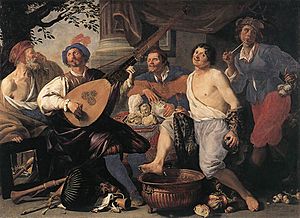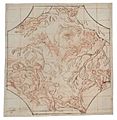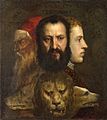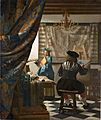Allegory facts for kids
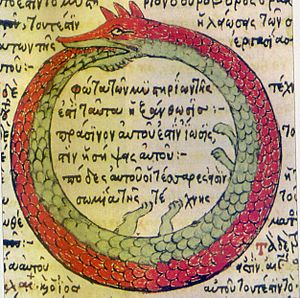
An allegory is a term for a figure of speech. It is a story or picture with a hidden meaning. The characters in allegories are symbols which represent particular ideas. The story has a figurative meaning, not just a literal one.
Allegory is an example of rhetoric, but an allegory does not have to be a story in language. It may be something to look at, such as a painting or sculpture.
An allegory is like a long metaphor. People have to use their imagination to understand what it is trying to say. A fable or parable is a short allegory with one basic idea (a moral).
Sometimes people say that stories have meanings which the author, in fact, did not intend. For instance, many people have suggested that The Lord of the Rings was an allegory for the World Wars, but, in fact, it was written well before the outbreak of World War II, and J.R.R. Tolkien said that it was not an allegory. In this way people sometimes change the author’s ideas.
Allegory has been a favourite form in the literature of nearly every nation. It is often used as a way of criticizing things or people where it would not be possible to do so directly.
Allegories still continue to be popular today. Pictures, movies and plays can be allegories. William Golding’s novel Lord of the Flies also has allegorical meaning. Star Trek used a great deal of allegory, to look at social conditions and moral values in the present, while telling stories based in the future. Alien races were often a reflection of Earth's own races and countries.
Allegorical artworks include Sandro Botticelli's La Primavera (Allegory of Spring) and Jan Vermeer's The Allegory of Painting.
Related pages
Images for kids
-
Pearl, miniature from Cotton Nero A.x. The Dreamer stands on the other side of the stream from the Pearl-maiden. Pearl is one of the greatest allegories from the High Middle Ages.
-
Albrecht Dürer, Melencolia I (1514): Unused tools, an hourglass, an empty scale surround a female personification, with other esoteric and exoteric symbols.
-
Titian, Allegory of Prudence (c. 1565–1570): The three human heads symbolise past, present and future, the characterisation of which is furthered by the triple-headed beast (wolf, lion, dog), girded by the body of a big snake.
-
The English School's Allegory of Queen Elizabeth (c. 1610), with Father Time at her right and Death looking over her left shoulder. Two cherubs are removing the weighty crown from her tired head.
-
Artemisia Gentileschi, Self-Portrait as the Allegory of Painting (c. 1638–39)
-
Jan Vermeer, The Art of Painting (c. 1666): Painting is shown as related to history and politics, the young woman being Clio, the muse of history, and other symbols for the political and religious division of the Netherlands appearing.
-
Flemish August Bouttats, Allegory of Triumphant Spain with immaculist banner, ca. 1682, cover of Triumphant Spain and the laureate church all over the world by the patronage of Holy Mary, Collection: Hispanic Society of America
See also
 In Spanish: Alegoría para niños
In Spanish: Alegoría para niños


